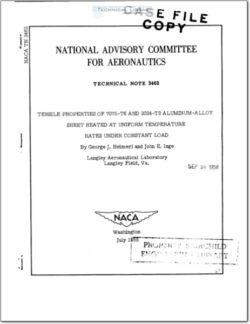NACA-TN-3462

- Version
- 213 Downloads
- 1.74 MB File Size
- 1 File Count
- December 4, 2015 Create Date
- December 4, 2015 Last Updated
National Advisory Committee for Aeronautics, Technical Notes - Tensile Properties of 7075-T6 and 2024-T3 Aluminum-Alloy Sheet Heated at Uniform Temperature Rates Under Constant Load

Results are presented of tests to determine the effect of heating
at uniform temperature rates from 0.20 F to 1000 F per second on the
tensile properties of 7075-T6 (formerly 75S-T6) and 2024-T3 (formerly
2hS-T5) aluminum-alloy sheet under constant—load conditions. The tem-
peratures at which yield and rupture occurred were determined for various
stress levels. Yield and rupture stresses, obtained under rapid-heating
and constant—load conditions, are compared with the results of elevated-
temperature tensile stress-strain tests of the same materials for l/2-hour
exposure. Linear and reciprocal temperature-rate parameters are derived
from the data. Master yield— and rupture-stress curves, based upon the
linear temperature parameter, are presented with which yield and rupture
stresses or temperatures may be predicted for these materials for tem-
perature rates from 0.20 F to 1000 F per second. A description of the
test equipment is included.
Aircraft and missile structural materials may be subjected to rapid
heating while under load because of aerodynamic heating at supersonic
speeds. Temperatures and temperature rates of the materials may vary
widely.
In order to provide information on the tensile properties of mate-
rials under rapid-heating conditions, some tests have been made of a
number of steels, titanium and aluminum alloys, and heat-resistant mate-
rials which were heated at high temperature rates under constant-load
conditions (refs. 1 to 6). The results obtained so far indicate that,
in general, metals and alloys can withstand substantially higher stresses
at a given temperature when heated at 1000 F to 200° F per second under
constant-load conditions than when loaded after the material has been
exposed 1/2 hour or longer at constant temperature. Increasing the tem-
perature rate from 2000 F to 2,0000 F per second or more results in only
a small additional increase in strength.
| File | Action |
|---|---|
| naca-tn-3462.pdf | Download |

Comment On This Post